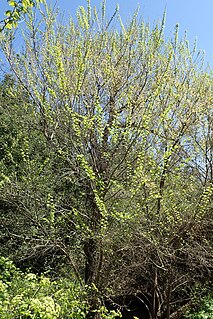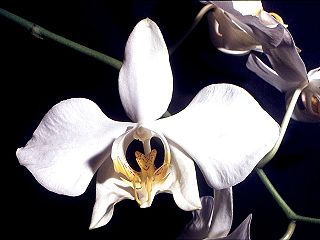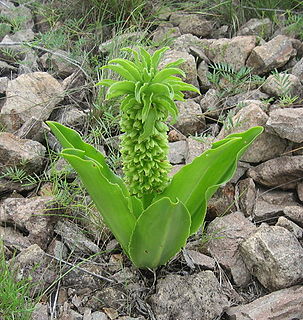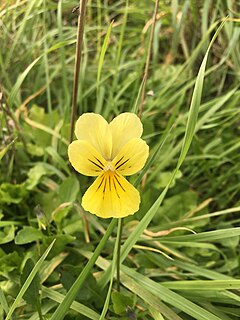
Royal Botanic Gardens, Kew, is a non-departmental public body in the United Kingdom sponsored by the Department for Environment, Food and Rural Affairs. An internationally important botanical research and education institution, it employs 1,100 staff. Its board of trustees is chaired by Dame Amelia Fawcett.

Streptocarpus sect. Saintpaulia is a section within Streptocarpus subgenus Streptocarpella consisting of about ten species of herbaceous perennial flowering plants in the family Gesneriaceae, native to Tanzania and adjacent southeastern Kenya in eastern tropical Africa. The section was previously treated as a separate genus, Saintpaulia, but molecular phylogenetic studies showed that it was nested within the genus Streptocarpus.

Viola canadensis is more commonly known as Canadian white violet, Canada violet, tall white violet, or white violet. It is widespread across much of Canada and the United States, from Alaska to Newfoundland, south as far as Georgia and Arizona.

Viola sororia, known commonly as the common blue violet, is a short-stemmed herbaceous perennial plant that is native to eastern North America. It is known by a number of common names, including common meadow violet, purple violet, woolly blue violet, hooded violet, and wood violet. Its cultivar 'Albiflora' has gained the Royal Horticultural Society's Award of Garden Merit.

Phormium colensoi (syn. Phormium cookianum ; wharariki, whararipi, whatariki, mangaeka, kōrari tuauru, wauraki, mountain flax, coastal flax, hill flax, lesser New Zealand flax, is a perennial plant that is endemic to Aotearoa New Zealand. It is less common than the other Phormium species, harakeke P. tenax J.R.Forst. et G.Forst. The greenish, yellow or orange flowers are followed by twisted seed pods.

Ulmus minorsubsp.canescens is a small deciduous tree occasionally known by the common names grey elm, grey-leafed elm, and hoary elm. Its natural range extends through the lands of the central and eastern Mediterranean, from southern Italy, the islands of Sicily, Malta, Crete, Rhodes and Cyprus, to Turkey, and as far south as Israel, where it is now considered rare and endangered in the wild. The tree is typically found amidst the comparatively humid coastal woodlands and scrublands.
Prismatomeris fragrans is a species of tree in the Rubiaceae family. It is found in Southeast Asia. The subspecies Prismatomeris fragrans subsp. andamanica is found only on the Andaman Islands.

Phalaenopsis amabilis, commonly known as the moon orchid or moth orchid in India and as anggrek bulan in Indonesia, is a species of flowering plant in the orchid family Orchidaceae, native to the East Indies and Australia, and widely cultivated as a decorative houseplant. It is an epiphytic or lithophytic herb with long, thick roots, between two and eight thick, fleshy leaves with their bases hiding the stem and nearly flat, white, long-lasting flowers on a branching flowering stem with up to ten flowers on each branch.

Pulsatilla patens is a species of flowering plant in the family Ranunculaceae, native to Europe, Russia, Mongolia, and China. Common names include Eastern pasqueflower and cutleaf anemone.

Eucomis autumnalis, the autumn pineapple flower, or autumn pineapple lily, is a species of flowering plant in the family Asparagaceae, subfamily Scilloideae, native to Malawi, Zimbabwe and southern Africa. It is a mid to late summer flowering deciduous bulbous perennial. The flower stem reaches about 40 cm (16 in), rising from a basal rosette of wavy-edged leaves. The green, yellow or white flowers are arranged in a spike (raceme), topped by a "head" of green leaflike bracts. It is grown as an ornamental garden plant and can also be used as a cut flower.

Dendrobium discolor, commonly known as antler orchids, are epiphytic or lithophytic orchids in the family Orchidaceae. They have cylindrical pseudobulbs, each with between ten and thirty five leathery leaves, and flowering stems with up to forty mostly brownish or greenish flowers with wavy and twisted sepals and petals. Antler orchids occur in northern Australia, New Guinea and Indonesia and there are several subspecies and varieties.

Hypericum aegypticum, also known as Egyptian Saint John's wort, is an evergreen shrub or shrublet in the section Adenotrias of the genus Hypericum. Less frequently, dwarf Saint John's wort is used as an alternate name.

Pachycentria glauca is a small epiphytic shrub in the Melastomataceae family. It has 2 subspecies: P. glauca subsp. glauca and P. glauca subsp. maingayi. The glauca subspecies is endemic to Borneo, the maingayi subspecies is native to Peninsular Malaysia and Thailand, perhaps Sumatera. It grows on trees, other epiphytes and rocks in partial shade. It is intimately associated with particular ant species, growing on their gardens, providing a home for them, feeding them and having its seeds dispersed by them.

Viola lutea subsp. calaminaria is a subspecies of V. lutea, in the violet family, the Violaceae. The plant occurs from Kelmis in the Belgian province of Liège across the borders to Germany and the Netherlands. The plant has adapted to an excess of zinc in the tailings of a former mines, the heaps of stone left over after separating the valuable fraction of ore. By evolving the ability to cope with the toxic heavy metal pollution, this violet has gained an advantage over the other plants in the ecosystem, as is able to become the locally dominant floral component of such habitats.

Viola hispida is a plant species in the genus Viola. It is endemic to France.
Astilbe glaberrima, called the florist's spiraea and smooth rock astilbe, is a species of flowering plant in the genus Astilbe, native to Yakushima Island, Japan. Some authorities have it as a subspecies of Astilbe japonica, Astilbe japonica subsp. glaberrima. Its dwarf variety Astilbe glaberrima var. saxatilis has gained the Royal Horticultural Society's Award of Garden Merit.

Scabiosa columbaria, called the small scabious and dwarf pincushion flower, is a widespread species of flowering plant in the genus Scabiosa, native to Europe, Africa, and western Asia, from Sweden to Angola. It is a short-lived perennial in the garden. In the wild in Europe it prefers to grow in calcareous grasslands.

Carex lepidocarpa, called the long-stalked yellow-sedge, is a species of flowering plant in the genus Carex, native to eastern Canada, Morocco, and most of Europe. It is a member of the Carex flava species complex.

Juncus tenageia, called the sand rush, is a species of flowering plant in the genus Juncus, native to northwestern Africa, many of the Mediterranean islands, warmer parts of southern, central and eastern Europe, and western Asia including Turkey, the Caucasus region, and Kazakhstan. It is typically found growing in wet, nutrient-poor rock, sand or clay-based soils, often on the edges of roads, clay pits and old brickyards.

















